A Late Autumn day tour today, in North Norfolk. It was a nice day, with high cloud but dry and mild and with light winds. A good day to be out birding. We met in Wells and headed east along the coast road.
On our way, as we passed Stiffkey, we had a quick look in the wet field beside the road just beyond the village. The cows were very close to the verge and there, with them, were not one but now two Cattle Egrets. There is nowhere to stop here but we managed to pull over where other cars could pass and wound down the windows for a closer look.
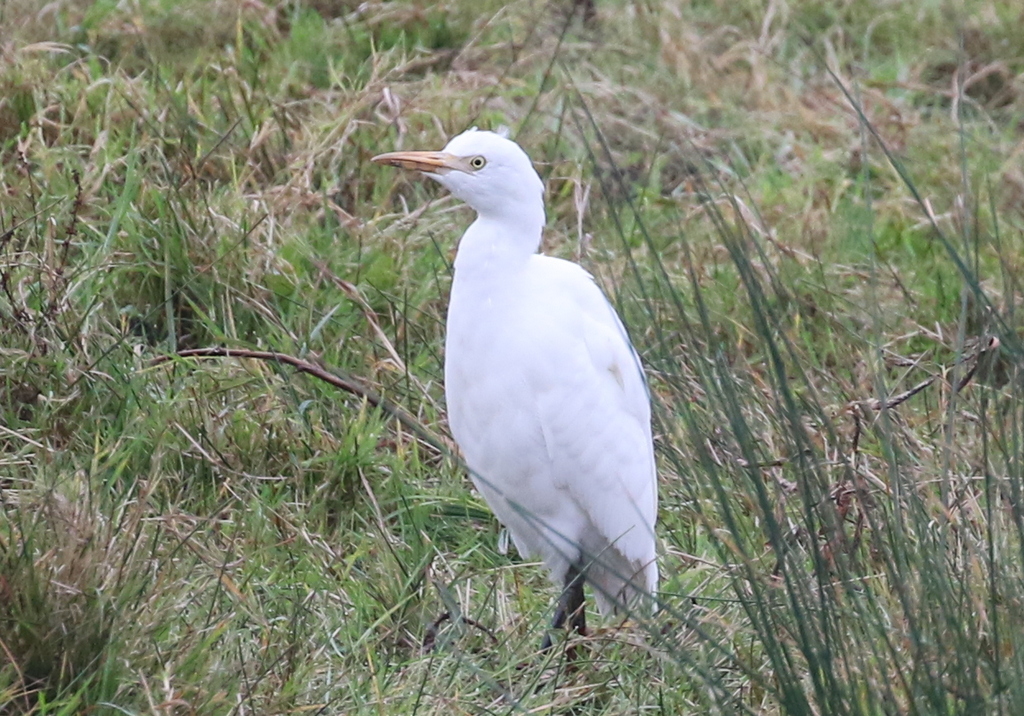 Cattle Egret – one of two at Stiffkey now
Cattle Egret – one of two at Stiffkey now
One of the two Cattle Egrets was standing right out in the open, and we got a good look at it through our binoculars – we could see its short yellowish bill. But it was spooked by another car passing us and flew further back. The second Cattle Egret managed to hide itself very successfully behind a cow at first, but eventually the cow moved out of the way and we could see that one well too, before it then flew further back into the field to join the first.
While we were watching the Cattle Egrets, a pipit flew up from the edge of the pool behind and circled over calling. We could hear a shrill, sharp call, though not as piercing as a Rock Pipit. It sounded like a Water Pipit – and helpfully was seen there again later by someone else at the site.
Our first destination proper for the day was Kelling. We parked in the village and walked up along the lane towards the beach. There were lots of Blackbirds and Chaffinches in the hedges, which flew off ahead of us as we made our way along. These were presumably mostly migrants, just arriving here for the winter.
A male Bullfinch flew out calling and landed briefly in the top of the next hedge over across the field. A Reed Bunting and a couple of Yellowhammers perched up in the top of a hawthorn with some of the Chaffinches, just long enough for us to get a good look at them. A Blackcap was not so obliging, flitting across the track and disappearing into the densest blackthorn.
When we got to a gap in the hedge, we stopped to scan the fields. A flock of about 30 Fieldfares was perched in the top of the bushes just across the field and we were able to get them in the scope, before they flew off west over the track ahead of us, chacking. They were followed by a group of Starlings. This was to be a theme of the day, with flocks of Starlings passing overhead west continually all day, birds arriving in from the continent for the winter.
There were other birds moving today too. Several Skylarks passed high overhead calling as we walked along the lane, seemingly on their way west. We heard Redpolls calling overhead too. In the hedge north of the copse, a Goldcrest was probably also a migrant arrived for the winter. When we got to the edge of the Quags, a female Stonechat was flycatching from the brambles and was joined by a couple of Meadow Pipits which flew up from the grass and stopped there to preen.
Looking across at the pool on the Water Meadow, a flock of about twenty Dunlin were busy feeding feverishly on the exposed mud along the near edge. A Common Redshank was with them. Further back, we found the Spotted Redshank weaving in and out of the rushes on the edge of the island. We got it in the scope and could immediately see how much paler it was than its commoner cousin, with a more strongly marked white supercilium and a longer, much finer bill.
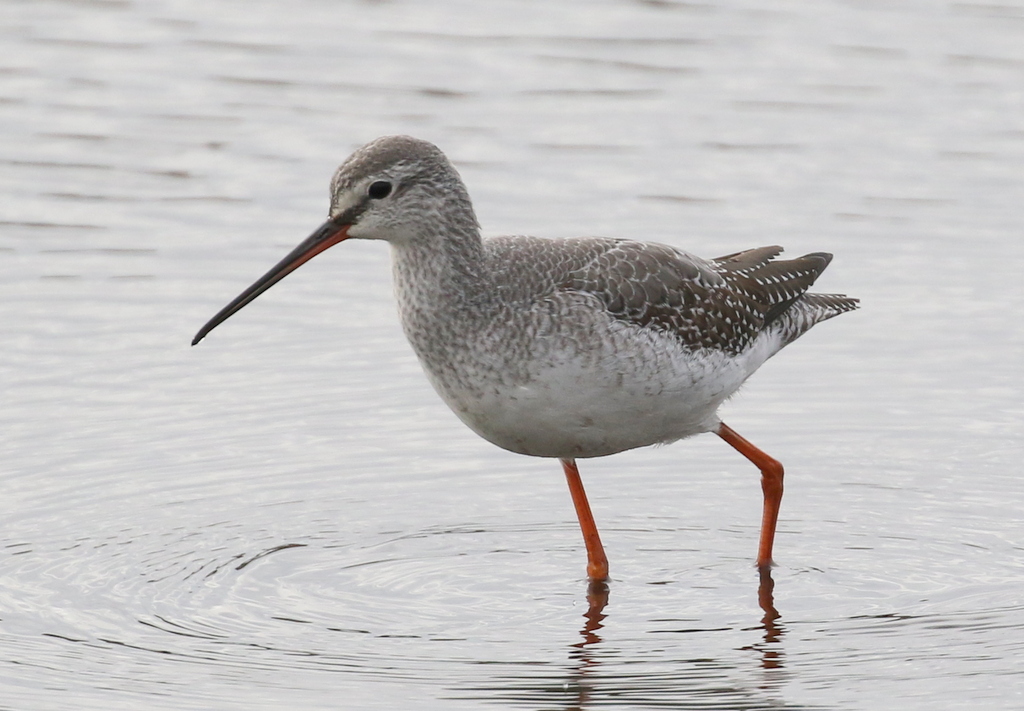 Spotted Redshank – lingering for several weeks here now
Spotted Redshank – lingering for several weeks here now
The Spotted Redshank, a 1st winter bird with darker grey retained juvenile wing coverts and tertials, has been lingering here for several weeks now – it will be interesting to see how much longer it stays here. The Spotted Redshank walked past a Common Snipe which was also feeding on the edge of the island.
There were a couple of other Common Snipe round the muddy edges of the pool too, helpfully feeding out in the open. The Jack Snipe are considerably more skulking – that one would take a bit more effort! Two Black-tailed Godwits flew in and circled over the pool nervously. They eventually dropped down into the water briefly, but changed their minds and took off again, flying off west.
At that point we noticed a report of a Sabine’s Gull which had apparently flown west past Cromer about 20 minutes earlier. It was headed our way, so we made our way straight to the beach to see if we could catch up with it. It later transpired the Sabine’s Gull had turned back and then appeared off Cromer again, so we didn’t manage to see it. But we did pick up a handful of Little Gulls moving west offshore – including a couple of slightly closer adults flashing alternately pale grey above and black underwings as they flapped.
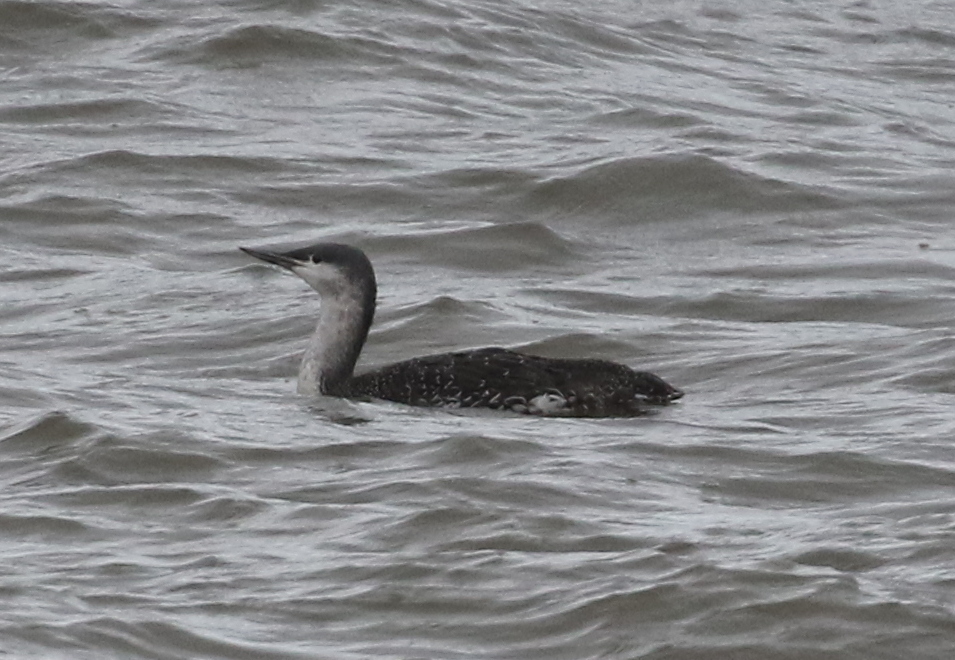 Red-throated Diver – there were several on the sea off Kelling today
Red-throated Diver – there were several on the sea off Kelling today
There were a few Gannets offshore too, mostly distant today though in the rather calm conditions. Several Red-throated Divers were closer in, including one diving just off the beach, in winter plumage now, dusky grey and white, with a rather pale face. A small group of female or juvenile Eider flew west, big chunky ducks with heavy wedge-shaped bills. While we were scanning the sea, a party of eleven Snow Buntings flew east along the shore line past us, calling. We could see as they dropped down onto the beach halfway towards Weybourne, so we set off to see if we could get a closer look.
We found the Snow Buntings again as they flew round and landed on the shingle some way ahead of us still. We got them in the scope and marvelled at how well camouflaged they are against the stones. A couple of them were running around on a patch of sand and were much easier to see. They all started to run up the beach towards a small patch of low sand cliff, and appeared to be feeding there, which gave us an opportunity to get much closer.
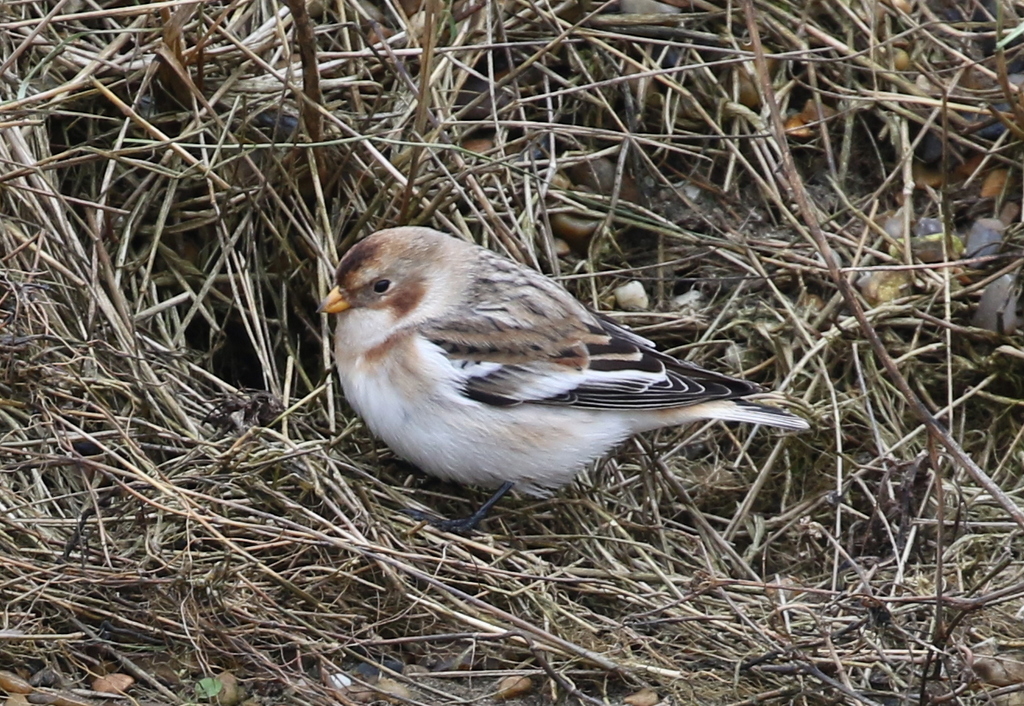 Snow Bunting – great views feeding along the edge of the beach
Snow Bunting – great views feeding along the edge of the beach
In the end, we had great close views of the Snow Buntings. There were some annual weeds growing at the top of the sand and the Snow Buntings were feeding on the plentiful seed, up on the top of the cliffs or looking for seed which had fallen off and landed down below. We could see the flock consisted of a mixture of paler Scandinavian birds (of the subspecies nivalis) and darker Icelandic Snow Buntings (insulae). After watching them for a while at close quarters, we left them busy feeding.
On our walk back to the Water Meadow, a female Stonechat was feeding on the brambles on the edge of the Quags, along with a Reed Bunting. We stopped by the pool to have a look for Jack Snipe. As we stood there, we could hear a Great Spotted Woodpecker call and we looked up to see it flying over our heads. There are no trees out here, so it landed on fence post instead, before continuing on its way west.
Jack Snipe are nowhere near as obliging as the Common Snipe, and spend a lot of their time skulking in the vegetation around the pool. They tend to be most active at dawn and dusk too and sleep for much of the day. After some very careful scanning, we just managed to spot a hint of a shape hidden deep in the grass. Getting the scope on it, we could see it was a Jack Snipe.
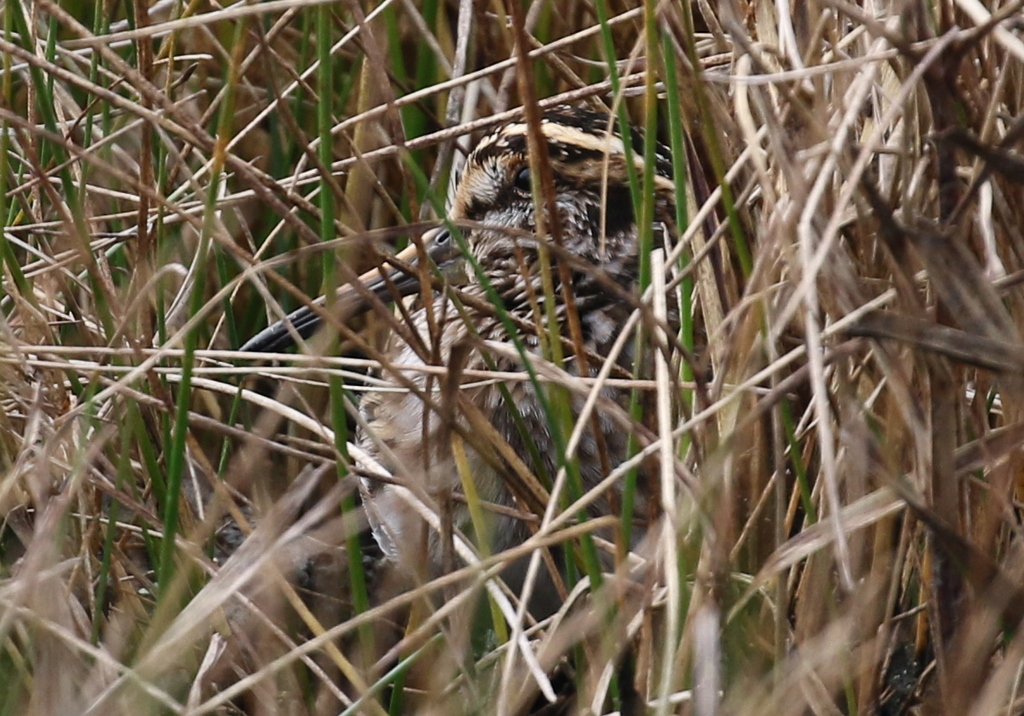 Jack Snipe – skulking in the grass by the Water Meadow
Jack Snipe – skulking in the grass by the Water Meadow
The Jack Snipe was asleep at first, brilliantly camouflaged in the tussocks of brown grass and rushes, and all but impossible to see unless you knew where it was. By changing our angle of view, we managed to build up a composite view of bits of it. Just occasionally it would wake for a couple of seconds and then sometimes it would start its characteristic bobbing motion, at which point it was marginally easier to find! It edged round a little and we found a spot from where we could see its face and bill through the vegetation.
While we were watching the Jack Snipe, the Spotted Redshank also put on a great performance for us, feeding up and down along the front edge of the pool, only a few metres away from us at times.
Eventually, we had to tear ourselves away and head back up the lane towards the car. We were halfway back when three small birds flew up from the weedy vegetation in the beck by the path. They were three Lesser Redpoll and they helpfully landed in the top of one of the low trees just behind us, waiting for us to move on so they could move back to where they were feeding. We could see they were small and quite dark brown-coloured.
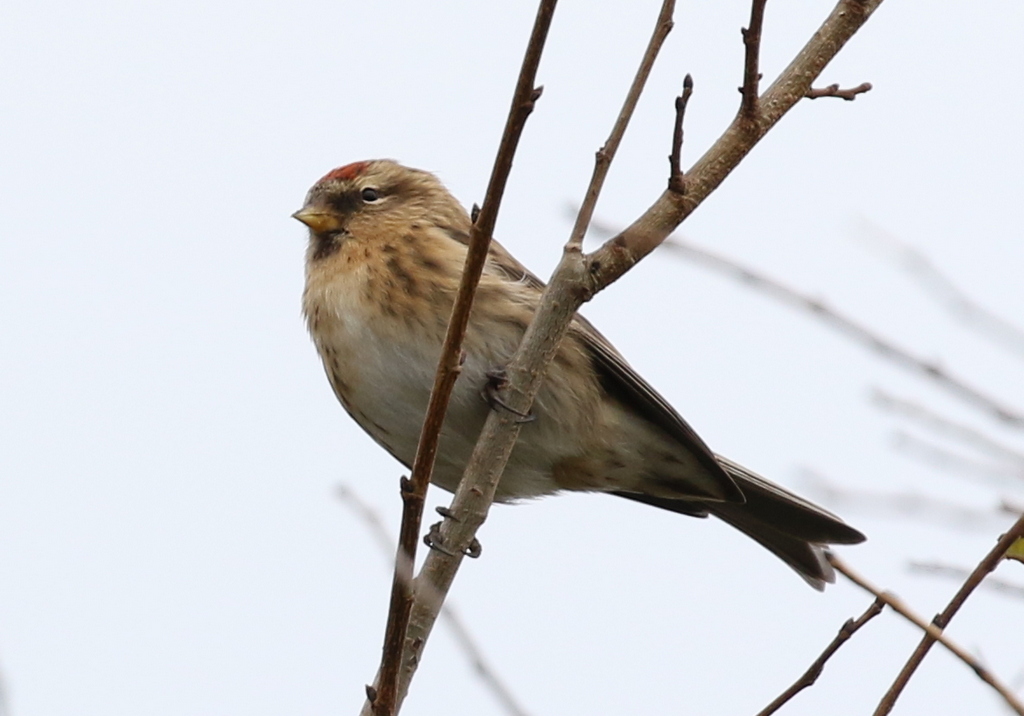 Lesser Redpoll – three were feeding in the lane on our walk back
Lesser Redpoll – three were feeding in the lane on our walk back
There has been a Black Brant with the Dark-bellied Brent Geese at Cley for a couple of weeks now, so we decided to go on a wild goose chase before lunch! The geese had been reported on the grazing marshes off the East Bank this morning, but there was no sign of any here when we got round there. The flock also likes to feed in the Eye Field, so we decided to have a quick look there next and sure enough there were the Brent Geese.
Some of the Brent Geese were feeding on the grass right by the road, so we pulled up carefully in the car and opened the windows. One of the closest birds to us was the Black Brant! It’s brighter white flank patch, contrasting more with its darker blackish body plumage, meant it immediately stood out from the duller Dark-bellied Brent Geese. We had a really good look at it from the car.
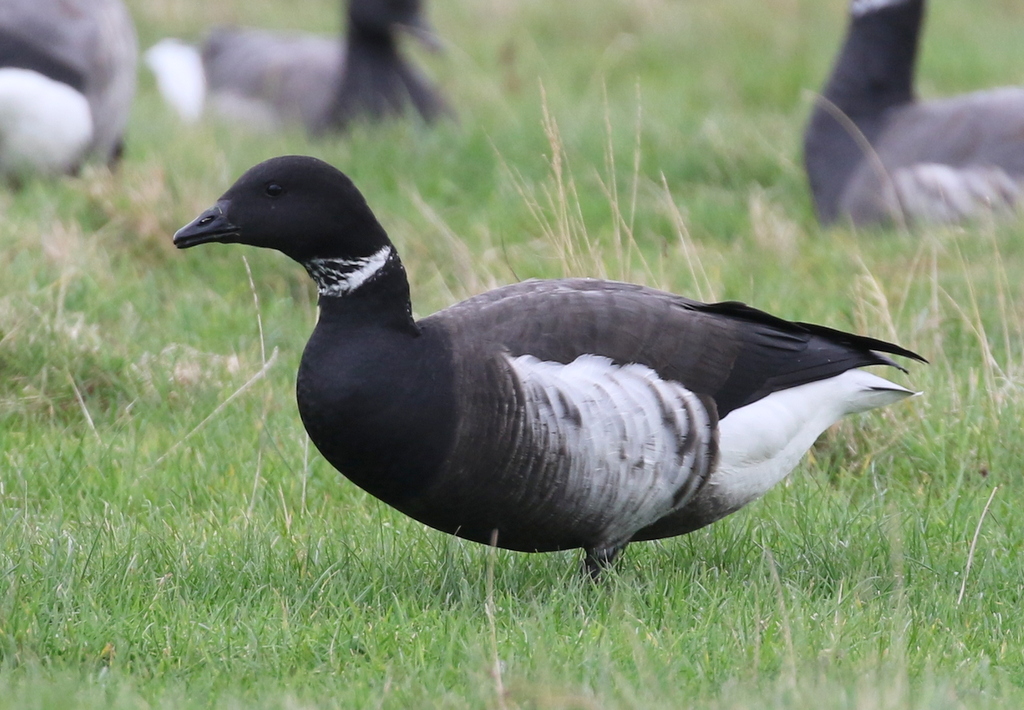 Black Brant – feeding right next to the Beach Road at Cley
Black Brant – feeding right next to the Beach Road at Cley
We then parked at the end of the road and had a look at the geese through the scope from the West Bank. We could see the Black Brant’s much better marked white collar, connecting under the chin and wrapping round a long way at the back too. Our regular wintering Dark-bellied Brents breed in northern Russia, with the Black Brant coming from for north-east Siberia or across the Pacific in NW North America. Occasionally Black Brants get lost and get in with the Dark-bellied Brents, at which point they may remain with them – this bird is probably a regular returnee, having been seen here for several winters now.
As we walked back to the car, a couple of Rock Pipits were chasing each other round the fishing boats and tractors on the edge of the beach. We headed back towards the visitor centre for lunch, but on the way back along the Beach Road one of the group spotted a wader flying over from the direction of the reserve. A Greenshank – it disappeared over the West Bank in the direction of Blakeney Harbour.
It was mild today, so we were able still to sit outside and eat our lunch at the picnic tables overlooking the reserve at Cley. As we ate, a large skein of Pink-footed Geese about a thousand strong came up from the fields in the distance beyond North Foreland wood. They came along the edge of the ridge and as they got closer we could hear their distinctive high-pitched yelping calls. Almost at the car park, they turned towards the reserve and started to whiffle down, losing height rapidly, before landing on the scrapes. Quite a spectacle!
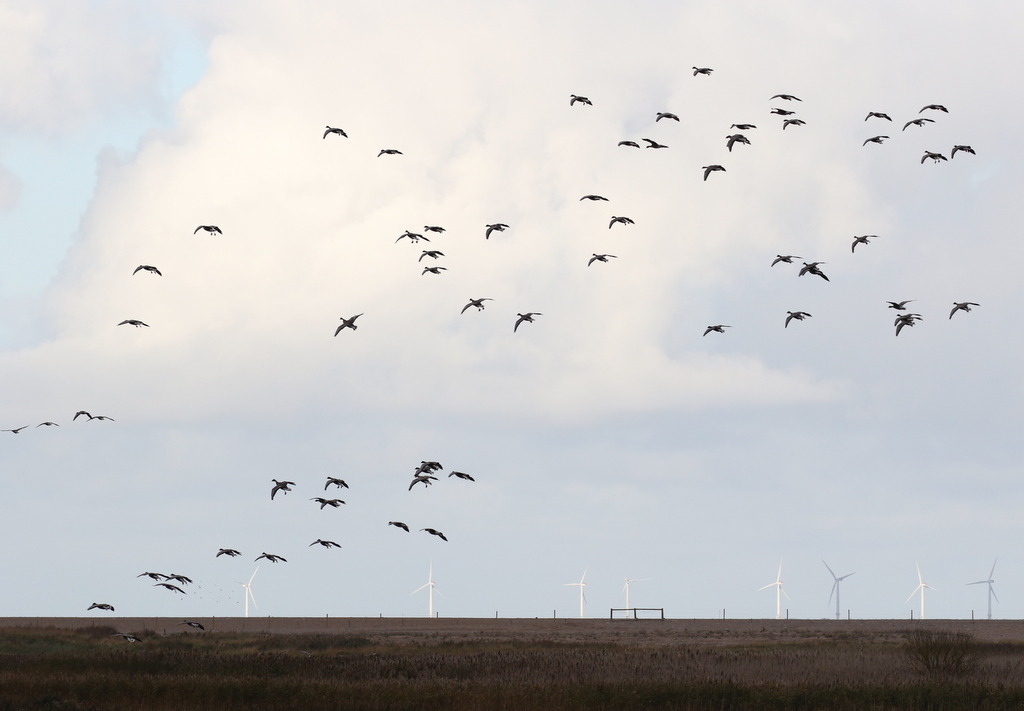 Pink-footed Geese – quite a sight, hundreds whiffling down towards the reserve
Pink-footed Geese – quite a sight, hundreds whiffling down towards the reserve
After lunch, we made our way round to Walsey Hills. A Yellow-browed Warbler had been reported here earlier and we thought we would like to try to get a look at it. A pair of Little Grebes were diving on the pool and we could hear a couple of Water Rails squealing from the reeds.
The Yellow-browed Warbler was frequenting the sallows at the back of Walsey Hills, a very dense area of cover. We headed out into the field at the back, where we could get a good look at the far edge of the trees. At first, all we could see were several tiny Goldcrests flitting around in the sallows. A flock of tits flew in from the wood and made their way through the trees. Then we heard the Yellow-browed Warbler call. We could just see it in the trees, but it disappeared behind a trunk and didn’t come out the other side. It was a good start, but we would like a better view.
After a few minutes, someone shouted to say the Yellow-browed Warbler was visible from the path through the trees, but by the time we got round there it had disappeared again. There was a better view of the trees from back out in the field and thankfully the Yellow-browed Warbler reappeared there after a couple of minutes. It never came out onto the edge, but we could see it flicking around in the leaves, noting its bright pale supercilium and wing bars. Amazing to think this tiny warbler had come all the way from the Urals, or even beyond!
We headed back across the road to the East Bank next. A Stock Dove flew up from the grazing marsh and disappeared off inland over the trees. We could hear Bearded Tits calling from the reeds behind Don’s Pool, but the most we could see of them was the occasional long-tailed shape darting across before diving back into cover.
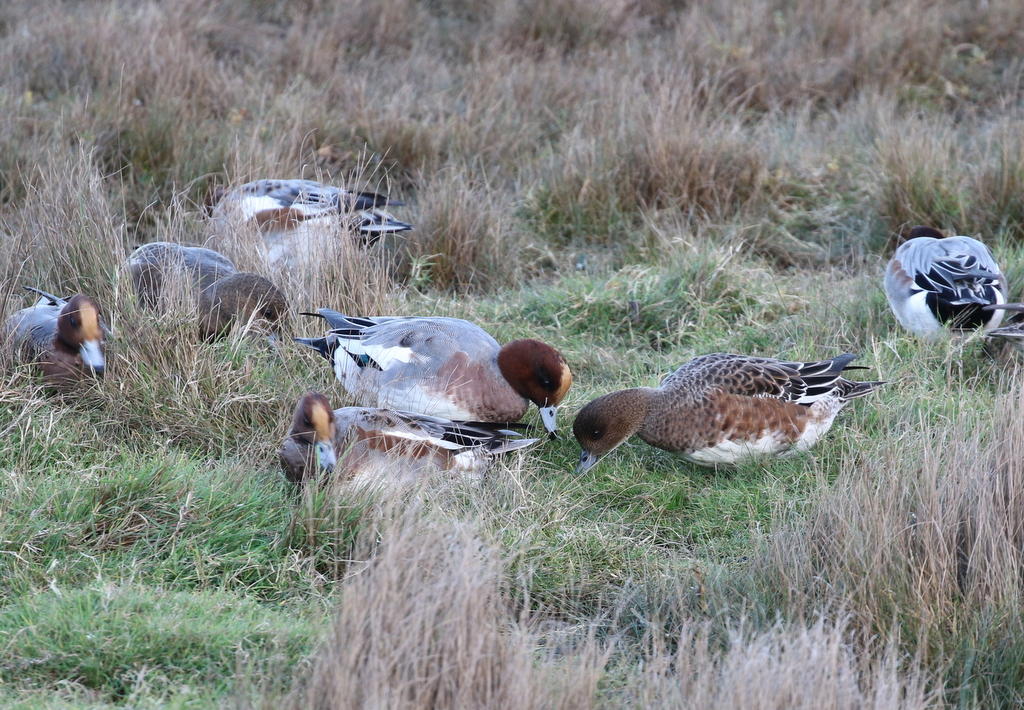 Wigeon – feeding out on the grazing marshes in good numbers now
Wigeon – feeding out on the grazing marshes in good numbers now
There were good numbers of ducks out on the grazing marshes. More Wigeon have returned now and there were several good sized groups feeding down in the grass below the bank. There were plenty of Teal too, particularly around the Serpentine, where a more careful scan also revealed a few Pintail and Gadwall. There were a few waders here too, several Black-tailed Godwits feeding on the Serpentine and further back, on Pope’s Pool, we could see a little group of Dunlin and a few Redshank.
There were more waders on Arnold’s Marsh. Looking carefully through all the Dunlin on here we found a single diminutive Little Stint with them, running round on the edge of one of the shingle spits. There were also several Grey Plover, Curlew and a single Turnstone on here, plus more Black-tailed Godwits and Redshank. A big flock of Linnets whirled round repeatedly, before dropping back down onto the saltmarsh to feed.
 Curlew – there were several on Arnold’s and around the brackish pools
Curlew – there were several on Arnold’s and around the brackish pools
We continued on to the beach to have another quick look out to sea. Although the wind had finally swung round to the north-west, it was still rather too light to blow anything inshore. A small flock of Ringed Plover flew past along the beach. Further out, a lone Common Scoter flew west, as did a single Brent Goose. We picked up a small group of six Shelduck flying in over the sea, presumably returning from the continent where they had gone to moult. Several Kittiwakes were circling distantly, feeding offshore.
As we made our way back along the East Bank, the sun was already going down. We stopped to watch a Little Egret feeding on the brackish pools in the evening light – shaking its feet ahead of it in the mud, trying to stir up fish or other invertebrates from the shallows. When it lifted its feet out of the water, we could see they were bright yellow, contrasting with its black legs.
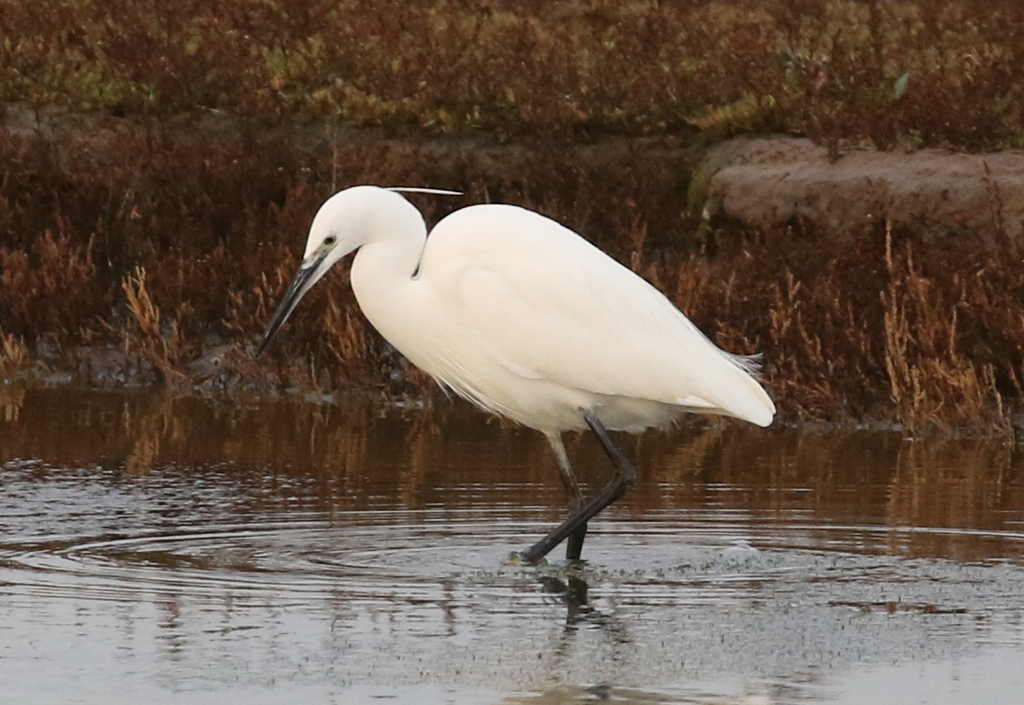 Little Egret – feeding in the brackish pools
Little Egret – feeding in the brackish pools
The light was already starting to fade but we still had time for one more quick stop on our way back west, at Stiffkey Greenway. The evenings draw in much earlier now, after the clocks have changed. As we pulled up into the car park, several small groups of Little Egrets were making their way west to roost.
We were hoping to catch up with some raptors to end the day. A distant Merlin appeared briefly against the sky, but we lost it as it dropped down against the saltmarsh again. A Peregrine was easier to see, standing out on the sand in the distance and a Common Buzzard perched in the top of the bushes at the back edge of the saltmarsh. We did manage to find a couple of Hen Harriers, but they were distant today. First a grey male appeared, way out in front of East Hills, but it almost immediately dropped down onto the saltmarsh out of view. Then a little later a ringtail appeared in the same area. It at least flew around for a while, but the light was really going now and it was very hard to get everyone onto against the dark of the trees.
With the evening drawing in, it was time to call it a day and head back to Wells. It had been a great day out, with some good birds, a nice mixture of late autumn migrants and winter visitors.
















